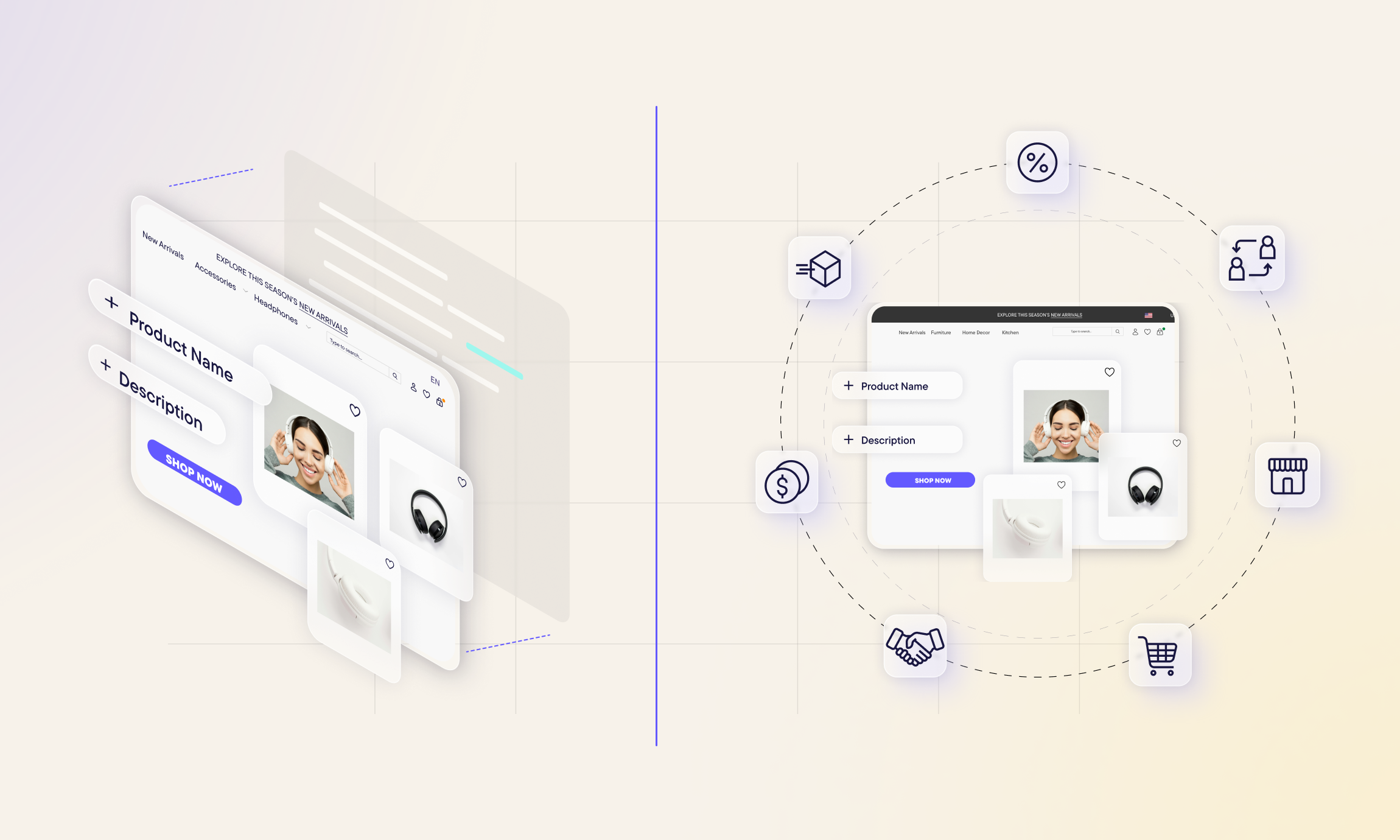
What you’ll learn:

Introduction
Businesses constantly seek innovative ways to deliver captivating experiences to their customers, so finding the ideal solution to manage content and seamlessly integrate it with their eCommerce platforms is crucial. Sometimes, tech professionals aren’t sure which solution best suits their needs: A headless CMS or a frontend-as-a-service (FEaaS) platform like commercetools Frontend.
This blog explores the differences between CMS solutions and commercetools Frontend, highlights their strengths and limitations and outlines how they can work harmoniously to support modern commerce experiences so that you can pick the right solution for your business.
What is a CMS?
A Content Management System (CMS) is software that enables teams to create, manage and publish digital content, typically through an intuitive interface that requires minimal coding. There are two broad categories:
Traditional CMS (e.g., WordPress, Adobe Experience Manager, Sitecore): tightly couples content management with content presentation. While easy to implement, traditional CMSs offer limited flexibility, especially across multiple channels or devices.
Headless CMS (e.g., Contentful, Sanity, Strapi): decouples the backend (content creation and storage) from the frontend (presentation). Content is delivered via APIs, allowing developers to design experiences for any channel, from websites and apps to IoT devices.
A CMS is particularly beneficial for websites that frequently produce or update content. Computed content includes various content components, such as a headline, an author paragraph, a summary section, multiple images, etc.
You need a headless CMS if your business:
Publishes or updates content frequently.
Delivers content to multiple channels (e.g., web, mobile, kiosks).
Requires structured content components (e.g., authors, summaries, embedded media).
Needs editorial workflows and permission.
Manages multi-language or regional content.
What is frontend-as-a-service?
Frontend-as-a-service gives businesses the ability and flexibility to craft high-performing digital storefronts without the burden of managing underlying infrastructure or concerns about scalability and performance. By simplifying frontend development with pre-built components, templates and integrations, your business can reduce costs, expedite time to market and leverage limitless customization options for frontends.
| All-in-one platforms | FEaaS | Custom builds |
|---|---|---|
| While having all features in one place can be convenient, this approach might make it more challenging to maintain, adapt and evolve frontends over time. | Pre-built models, ready-made integrations, store launchpads and no-code solutions provide the perfect balance of customization, collaboration and rapid time to market, catering to marketers and developers alike. | While fully customizable solutions offer extensive flexibility, they can be time-consuming and resource-intensive, often catering primarily to developers. |
What is frontend-as-a-service?
commercetools Frontend is a Frontend-as-a-Service (FEaaS) platform, a cloud-native, API-first solution that provides the infrastructure, orchestration and tooling to build and manage highly customizable frontend applications. It empowers teams to deliver fast, modern web experiences, often built as Progressive Web Apps (PWAs), without the overhead of managing backend systems.
This empowers developers with the tools to design fully functional and optimized websites, offering engaging and differentiated experiences across all digital touchpoints.
While a headless CMS is focused on content delivery, a FEaaS solution is about building frontends from end to end. In a nutshell, these systems are complementary and can work well together.
commercetools Frontend is ideal when you want to:
Build composable frontend experiences quickly.
Launch and manage PWAs across multiple markets.
Empower developers with API-first architecture and reusable components.
Orchestrate data from multiple sources (CMS, commerce, search, etc.).
Provide business users with low-code tools for customizing the storefront.
Conversely, suppose you’re a smaller business with a relatively static site (e.g., a few landing pages updated quarterly) or a B2B enterprise. In that case, the lightweight CMS-like features within commercetools Frontend might be sufficient.
If rich content is at the heart of your digital strategy, pairing commercetools Frontend with a headless CMS is the way to go.
How headless CMS and commercetools Frontend work together
The real magic happens when commercetools Frontend and a headless CMS are used in tandem.
Here’s how the integration works:
Content creation in CMS: Content editors create structured content (text, images, metadata) using the CMS’s backend interface.
Content delivery via APIs: The headless CMS exposes content through APIs, enabling other services — like commercetools Frontend — to consume and render that content.
Frontend orchestration: commercetools Frontend handles the UI layer, orchestrating content from the CMS alongside data from the commerce backend, search, personalization, etc.
Page building and optimization: Using Frontend Studio, business users and developers collaboratively build and optimize pages for performance and experience.
Deployment and hosting: commercetools Frontend manages deployment and delivery, ensuring fast, scalable and resilient digital experiences.

Flexibility: Businesses gain greater flexibility by decoupling the frontend and backend systems. Frontend developers have more control over the user experience, as they can design and update the frontend independently from the backend. This separation of concerns allows for faster iterations and enhanced customization possibilities.
Scalability: With the ability to handle multiple markets and channels, a headless CMS becomes a valuable asset for businesses to expand their digital presence. commercetools Frontend complements this scalability with robust developer tools and workflows.
Multi-channel content delivery: Headless CMS can serve as a central content source, delivering consistent content across multiple channels. With commercetools Frontend’s fastest API portfolio powering the backend, content orchestration and distribution ensure that content is presented consistently across various third-party systems and touchpoints.
Faster time to market: FEaaS streamlines deployment pipelines; CMS editorial tools speed up content publishing.
Australian fashion group APG & Co. chose to leverage the commercetools Frontend andCMS combo, which led to a 35% reduction in technology costs and a 60% decrease in operational technical support time.
Interested in connecting commercetools Frontend with a headless CMS?
💡Check the integration guide.Create stunning digital storefronts starting today
Choosing between a CMS and a frontend solution isn’t a binary decision. Instead, it's about understanding what each tool excels at and how they complement each other. Combining a headless CMS and commercetools Frontend offers unmatched flexibility, speed and scalability, especially for enterprises operating across channels and markets.
Download The Business Leader Guide to Digital Storefront Technology to learn more.